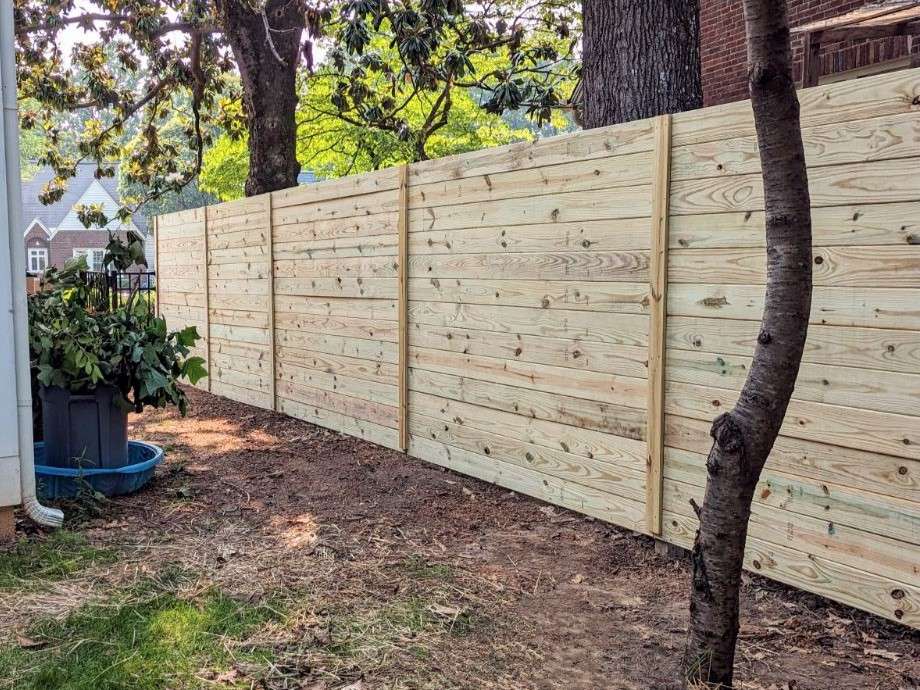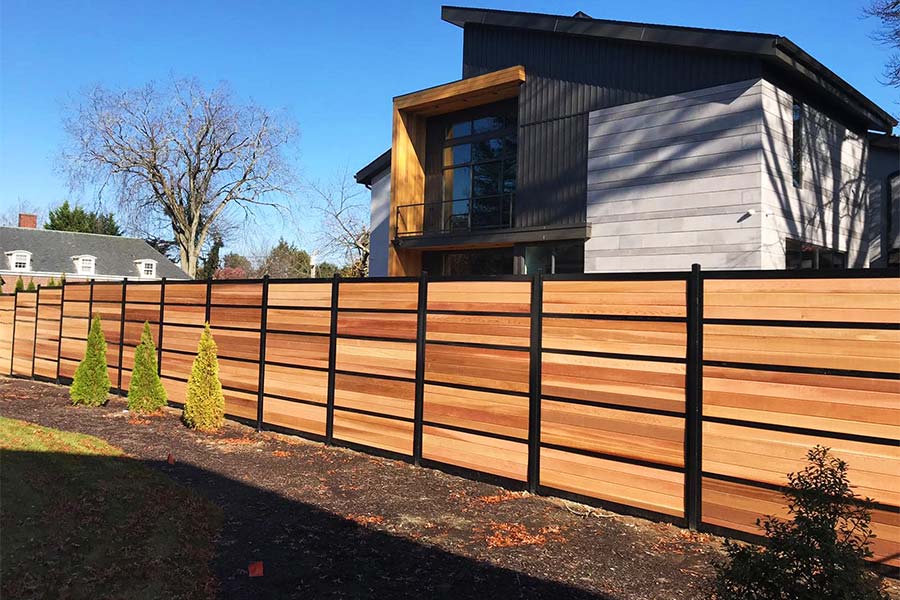All Categories
Featured
Your fence is a financial investment that offers safety, personal privacy, and visual appeal. Each secure fencing type has unique maintenance requires based on its material's longevity, exposure to the aspects, and other aspects.
![]()
Weather Defense: Use a top quality sealer or stain every 2-- 3 years to shield the timber from wetness and UV rays. For extreme environments, yearly reapplication might be required. Cleaning: Use a yard hose pipe or a stress washer on a low setup to get rid of dust and mildew. Comply with up with a mild detergent for stubborn discolorations. Repair services: Inspect for loose or deteriorating boards and change them promptly. Tighten up screws or nails to keep the structure stable. Bug Control: Usage termite-resistant timber or deal with the fencing with bug repellents to stay clear of infestations. 2. Plastic Fences. Vinyl fences are preferred for their longevity and marginal upkeep requirements.
Cleansing: Wash the surface with a garden pipe or a blend of soap and water to get rid of dirt and algae. For tough stains, make use of a vinyl-specific cleanser or a soft-bristle brush. Examinations: Consistently examine for cracks or warping, especially after solid winds or hefty impacts. Fixings: Change any type of broken sections immediately. Vinyl fencings typically use modular elements, making repairs straightforward. 3. Chain-Link Fences. Chain-link fences are cost-efficient and sturdy however require routine interest to avoid corrosion.
Corrosion Removal: Use a cord brush to eliminate rust from subjected locations, after that apply a rust-inhibiting spray to secure the steel. Cleaning: Hose down the fencing regularly to eliminate dirt. For grime, use soapy water and a stiff-bristle brush. Fixings: Tighten up any type of drooping sections or replace damaged links to keep safety. 4. Wrought Iron Fencings. Wrought iron fencings offer sturdiness and style however are vulnerable to corrosion otherwise properly kept.
![]()
Corrosion Prevention: Remove rust areas with sandpaper and use a rust-resistant primer followed by outdoor metal paint. Check for corrosion at the very least two times a year. Cleansing: Wipe down with a towel and soapy water to preserve the coating. Stay clear of abrasive cleaners that can harm the surface area. Repainting: Paint every couple of years to shield the steel from deterioration and keep it looking fresh. 5. Aluminum Fences. Light weight aluminum fences are lightweight, sturdy, and immune to corrosion, calling for less maintenance compared to wrought iron.
Cleaning: Tidy with soap and water to get rid of dust and dirt. Wash thoroughly to stop deposit. Examinations: Look for loosened hardware or damages, particularly after tornados. Secure or change parts as required. Touch-Ups: Apply paint to scratched or cracked areas to prevent damage to the safety layer. 6. Compound Fences. Composite fencings are made from a mix of wood and plastic, incorporating resilience with marginal maintenance.
![]()
Cleansing: Make use of a pipe or a soft brush with soap and water to cleanse the surface. Avoid making use of severe chemicals. Evaluations: Seek warping, especially in severe warm. Tighten up or change any type of broken panels. Build Prevention: While composite materials resist rot, keep the fencing completely dry and tidy to prevent mold and mildew buildup. 7. Bamboo Fences. Bamboo is an environmentally friendly option however requires mindful upkeep to keep its look and durability.
Securing: Use a safety sealer or varnish every 2-- 3 years to defend against moisture and UV damage. Cleansing: Tidy with moderate soap and a soft sponge or brush. Prevent high-pressure washing, which can damage bamboo fibers. Fixings: Change harmed posts or areas to maintain architectural integrity and appearance. General Upkeep Tips for All Secure Fencing Types. Normal Examinations: Examine your fence at the very least once every period for damage, wear, or loose parts. Cutting Vegetation: Maintain vines, bushes, and plants far from the fencing to avoid dampness damage and lessen pest task. Seasonal Changes: In regions with snow, stay clear of piling snow versus your fence to stop architectural stress. In warm climates, evaluate for heat-related bending or fading. Final thought. Each secure fencing material has its unique maintenance requirements, however an aggressive strategy to care can expand its life-span and maintain it looking its finest. Wood fences require more interest compared to vinyl or light weight aluminum, however each material benefits from normal cleansing, inspections, and prompt repair work. By customizing your maintenance techniques to the sort of fence you own, you'll ensure that it continues to supply curb, safety, and privacy charm for several years to find.

- Wooden Fencings. Wooden fences are valued for their natural appearance however require constant maintenance to avoid damages.
Weather Defense: Use a top quality sealer or stain every 2-- 3 years to shield the timber from wetness and UV rays. For extreme environments, yearly reapplication might be required. Cleaning: Use a yard hose pipe or a stress washer on a low setup to get rid of dust and mildew. Comply with up with a mild detergent for stubborn discolorations. Repair services: Inspect for loose or deteriorating boards and change them promptly. Tighten up screws or nails to keep the structure stable. Bug Control: Usage termite-resistant timber or deal with the fencing with bug repellents to stay clear of infestations. 2. Plastic Fences. Vinyl fences are preferred for their longevity and marginal upkeep requirements.
Cleansing: Wash the surface with a garden pipe or a blend of soap and water to get rid of dirt and algae. For tough stains, make use of a vinyl-specific cleanser or a soft-bristle brush. Examinations: Consistently examine for cracks or warping, especially after solid winds or hefty impacts. Fixings: Change any type of broken sections immediately. Vinyl fencings typically use modular elements, making repairs straightforward. 3. Chain-Link Fences. Chain-link fences are cost-efficient and sturdy however require routine interest to avoid corrosion.
Corrosion Removal: Use a cord brush to eliminate rust from subjected locations, after that apply a rust-inhibiting spray to secure the steel. Cleaning: Hose down the fencing regularly to eliminate dirt. For grime, use soapy water and a stiff-bristle brush. Fixings: Tighten up any type of drooping sections or replace damaged links to keep safety. 4. Wrought Iron Fencings. Wrought iron fencings offer sturdiness and style however are vulnerable to corrosion otherwise properly kept.

Corrosion Prevention: Remove rust areas with sandpaper and use a rust-resistant primer followed by outdoor metal paint. Check for corrosion at the very least two times a year. Cleansing: Wipe down with a towel and soapy water to preserve the coating. Stay clear of abrasive cleaners that can harm the surface area. Repainting: Paint every couple of years to shield the steel from deterioration and keep it looking fresh. 5. Aluminum Fences. Light weight aluminum fences are lightweight, sturdy, and immune to corrosion, calling for less maintenance compared to wrought iron.
Cleaning: Tidy with soap and water to get rid of dust and dirt. Wash thoroughly to stop deposit. Examinations: Look for loosened hardware or damages, particularly after tornados. Secure or change parts as required. Touch-Ups: Apply paint to scratched or cracked areas to prevent damage to the safety layer. 6. Compound Fences. Composite fencings are made from a mix of wood and plastic, incorporating resilience with marginal maintenance.

Cleansing: Make use of a pipe or a soft brush with soap and water to cleanse the surface. Avoid making use of severe chemicals. Evaluations: Seek warping, especially in severe warm. Tighten up or change any type of broken panels. Build Prevention: While composite materials resist rot, keep the fencing completely dry and tidy to prevent mold and mildew buildup. 7. Bamboo Fences. Bamboo is an environmentally friendly option however requires mindful upkeep to keep its look and durability.
Securing: Use a safety sealer or varnish every 2-- 3 years to defend against moisture and UV damage. Cleansing: Tidy with moderate soap and a soft sponge or brush. Prevent high-pressure washing, which can damage bamboo fibers. Fixings: Change harmed posts or areas to maintain architectural integrity and appearance. General Upkeep Tips for All Secure Fencing Types. Normal Examinations: Examine your fence at the very least once every period for damage, wear, or loose parts. Cutting Vegetation: Maintain vines, bushes, and plants far from the fencing to avoid dampness damage and lessen pest task. Seasonal Changes: In regions with snow, stay clear of piling snow versus your fence to stop architectural stress. In warm climates, evaluate for heat-related bending or fading. Final thought. Each secure fencing material has its unique maintenance requirements, however an aggressive strategy to care can expand its life-span and maintain it looking its finest. Wood fences require more interest compared to vinyl or light weight aluminum, however each material benefits from normal cleansing, inspections, and prompt repair work. By customizing your maintenance techniques to the sort of fence you own, you'll ensure that it continues to supply curb, safety, and privacy charm for several years to find.
Latest Posts
Reliable Industrial Roofing Solutions by Weathercraft
Published May 27, 25
1 min read
How Regular Auto Maintenance at Montclare Auto Repair Keeps Your Wallet Happy
Published May 26, 25
1 min read
Find Premier Car Repair Solutions in Chicago – Expert Care for Your Vehicle
Published May 25, 25
1 min read
More
Latest Posts
Reliable Industrial Roofing Solutions by Weathercraft
Published May 27, 25
1 min read
How Regular Auto Maintenance at Montclare Auto Repair Keeps Your Wallet Happy
Published May 26, 25
1 min read
Find Premier Car Repair Solutions in Chicago – Expert Care for Your Vehicle
Published May 25, 25
1 min read